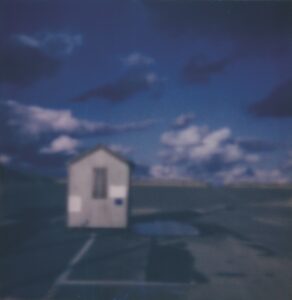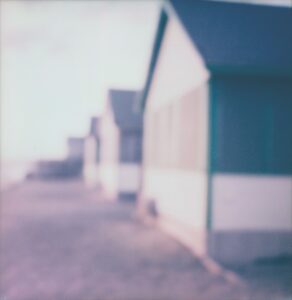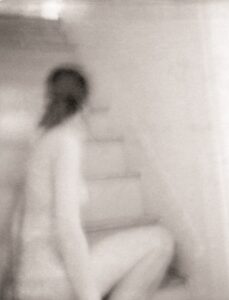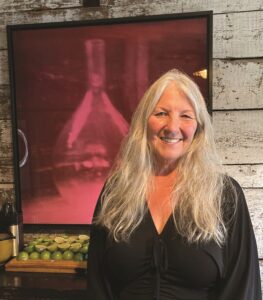“I was raised in a family that loved art,” says photographer Susan Mikula. “When somebody opens that door and does not say, ‘Don’t go through it,’ that makes all the difference. We were not a unified group, which is how I learned that art is so personal.”
Before she began her career as a photographer; before her education in American history, religion, and color theory at Hampshire College; and before she was riveted by the way human existence butts up against land and sea on the Outer Cape, Mikula was nurtured in a creative family. She speaks fondly of the times she and her parents and three siblings built dioramas of the Catacombs and the Parthenon. She also wrote and published short stories and taught herself to gild. Hand-building and respect for craft remain Mikula’s foundation.
The Outer Cape has been a source of inspiration and imagery for Mikula for over 30 years. Through the rest of August, a baker’s dozen of new images from Mikula’s “Moons of Neptune” series can be viewed at the Rice Polak Gallery, where she is represented locally.

Mikula’s work is also on view at the Mary Heaton Vorse house in Provincetown through Sept. 10, part of a show called “Into the Light: A 30-Year Anthology.”
The exhibition at the Vorse house features 75 images from Polaroid originals, digitally reprinted on a variety of surfaces — from delicate handmade paper to metal — and precisely mounted or framed. The rambling two-story Cape Cod cottage, once home to the labor journalist who chronicled Provincetown’s history in Time and the Town and now owned by the Provincetown Arts Society, is the perfect setting for Mikula’s misty, poetic images. Here, they seem to embody something of Vorse’s spirit, each illuminating a moment from the past just as it slips away.
Curious, well-read, and familiar with a wide range of visual art and literature — she refers to Joan Mitchell, Cy Twombly, and Cormac McCarthy as part of her palette and incorporates poetic imagery in everyday conversation — Mikula is also self-taught.
“Art school wasn’t on my horizon,” she says, though if she had another life ahead, she says, “I would go back to college for about three degrees. There’s never enough time to learn everything.”
What she has taught herself — about the multiple uses of antique cameras with their stubborn lenses and the history of rare Polaroid films and how to gingerly coax images from those past their expiration dates — can be mastered only through experience.

“If I get a camera, I just learn it,” she says. Mikula has worked with a wide range of Polaroids and antique cameras and found that “each one produces a different effect.” Their variability suits her. “My art comes through a mechanism,” she says, “so I have a very warm relationship with all of my cameras.”
When it comes to color, though, Mikula says, “It’s important to know what my film is going to do” — what colors are going to drop out first affects her decisions on what she will use a particular film for. “Colors are fugitive,” she says. When film gets older, the yellows and reds drop out before the blues and greens, which to her are ideal for expressing the indefinite edge between the material world and that which appears to float away, she says.
An image from her “Alden” series, on view at the Vorse house, directs the eye from a grassy meadow and an ancient mossy tombstone to a vertical monument, the edges softened to blue-gray and framed by a fading blue sky. It frames a compact plot in Provincetown’s expanse of cemeteries and brings to mind those buried here, from Norman Mailer and Robert Motherwell to a generation who died during the height of the AIDS pandemic.
“You think about Provincetown as being quite flat,” Mikula says. “The cemetery offers a different prospect. You’re all of a sudden on a knoll with rolling vistas.” From there, she says, “The rest of Provincetown drops away, like shining beads.”

The “Moons of Neptune” series is an expansive body of work with numbered pieces at both the Vorse house and Rice Polak Gallery. “Neptune is the farthest known planet in our solar system, wild and very windy,” Mikula says. “It’s all blues and blue-greens, and it has 14 known moons,” each moon providing her an opportunity to name and number a piece in the series.
The planet also provides an allegory for the Outer Cape, where one is 70 miles out into the ocean. “Neptune is the absolute ruler of the sea,” says Mikula. “Neptune’s presence and its pull on these moons is exactly like the Outer Cape to me.”
Over a chilly autumn week in 2017, Mikula, who lives in New York City, spent time in the Hawthorne Barn as part of the Twenty Summers artist-in-residence program. The large, open space, with its north-facing wall of windows, is treasured for its history: it was built in 1907 by Charles Webster Hawthorne, who established the Cape Cod School of Art, and decades later was used by Hans Hofmann and his students.
Mikula’s Hawthorne Barn, its sole subject a ruby-pink glass vase, commands a wall in one of the many small rooms at the Vorse house. An absence of color at its base suggests a gathering of light.

“What I wanted to work on was the experience of being there,” Mikula says. “It was raining. It was not heated.” She says she was “just learning the space and feeling the space, and it felt like the vase contained a kind of energy inside,” the accumulated atmosphere of those who had labored there before.
While Mikula’s “30-Year Anthology” is not a retrospective or a chronological progression, among the earliest works in the Vorse house show are two images in the series “After Reprimand,” in which the focus is a sculptural nude seated on a staircase and a lamp held aloft by two hands.
“During that shoot I was working on a closeness,” Mikula says. At the same time, she says, “I wanted to show how we think of light as coming from above.” In these images, the model’s body reflects that light. “The poet Jack Gilbert calls the body ‘soft machinery,’ ” Mikula says, “and that is how I want to represent that soft machinery in the geometric space.”
As for the series title, “The idea of ‘After Reprimand’ is about getting past the pressures and constrictions of the world,” Mikula says. “This is the place after that.”
Moon Dreams
The event: Susan Mikula’s “Moons of Neptune” series
The time: Aug. 17 to 30; opening reception Friday, Aug. 18, 7 p.m.
The place: Rice Polak Gallery, 430 Commercial St., Provincetown
The cost: Free; see ricepolakgallery.com for more information
Note: Mikula’s anthology “Into the Light” is also on view at the Mary Heaton Vorse house, 466 Commercial St., Provincetown through Sept. 10
